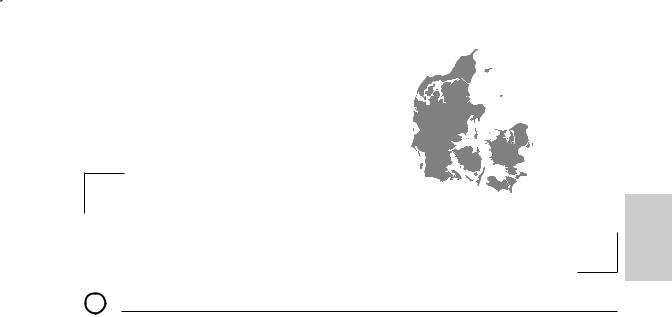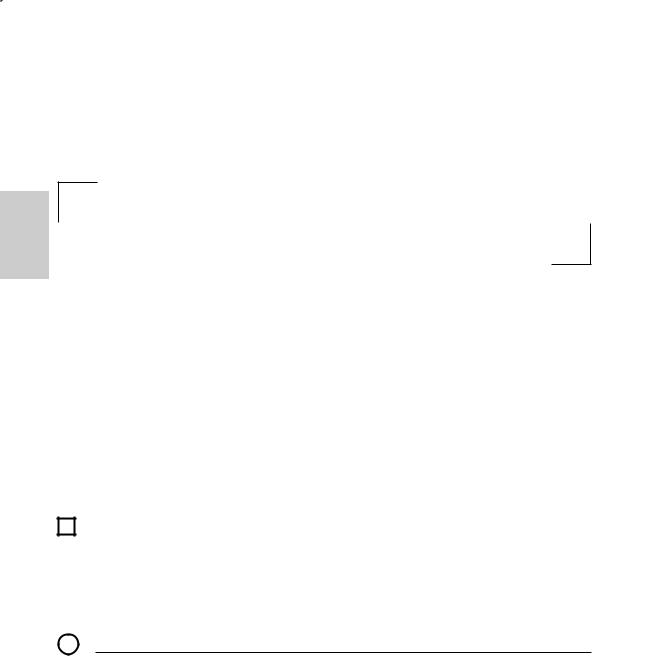
- •Contents
- •Preface
- •Introduction
- •Cultural Orientation
- •Argentina
- •Austria
- •Australia
- •Belarus
- •Belgium
- •Belize
- •Bolivia
- •Brazil
- •Canada
- •Chile
- •China
- •Hong Kong
- •Colombia
- •Costa Rica
- •Czech Republic
- •Denmark
- •Ecuador
- •Egypt
- •Finland
- •France
- •Germany
- •Greece
- •Guatemala
- •Honduras
- •Hungary
- •India
- •Indonesia
- •Ireland
- •Israel
- •Italy
- •Japan
- •Kuwait
- •Malaysia
- •Mexico
- •The Netherlands
- •New Zealand
- •Norway
- •Pakistan
- •Panama
- •Paraguay
- •Peru
- •Philippines
- •Poland
- •Portugal
- •Romania
- •Russia
- •Saudi Arabia
- •Singapore
- •South Africa
- •South Korea
- •Spain
- •Sweden
- •Switzerland
- •Taiwan
- •Thailand
- •Turkey
- •Ukraine
- •United Kingdom
- •United States
- •Uruguay
- •Venezuela
- •Vietnam
- •Index

Denmark
Kingdom of Denmark
Local short form: Danmark
Local long form: Kongeriget Danmark
Cultural Note
Alone of all the Scandinavian nations, Denmark has maintained extraterritorial possessions into modern times. Today, Denmark retains Greenland and the Faroe Islands. This requires the Danish government to consider the interests of those citizens and gives Danish artists extra inspiration. Part of Peter Høeg’s bestselling 1992 novel Smilla’s Sense of Snow takes place in Greenland.
Denmark
●3 What’s Your Cultural IQ?
1.Which of the following are true about “The Little Mermaid”—the famous statue in Copenhagen’s harbor?
a.She has been blown off her granite stone by explosives.
b.She has been decapitated.
c.Her right arm was cut off.
d.All of the above.
ANSWER: d. This beautiful statue is one of the most-often photographed pieces of art worldwide. It is also one of the most abused. A Danish brewer, Carl Jacobsen, commissioned the statue after attending a performance of The Little Mermaid in 1909. The Danish sculptor was Edward Eriksen.
3. Match these famous Danes with their areas of accomplishment:
a. Vitus Jonassen Bering (1681–1741) |
1. |
Astronomy |
b. Niels Bohr (1885–1962) |
2. |
Exploration |
c. Tycho Brahe (1546–1601) |
3. |
Quantum physics |
ANSWER: a. 2; b. 3; c. 1. Of the three, only physicist Niels Bohr died in Denmark. Brahe died in Prague, and Bering died on an island in what is now called the Bering Sea.
3.Which of the following Danes did not win the Nobel Prize for literature?
a.Karen Blixen, writing as Isak Dinesen (1885–1962)
b.Karl Adolph Gjellerup (1857–1919)
c.Johannes V. Jensen (1873–1950)
d.Henrik Pontoppidan (1857–1943)
ANSWER: a. Ironically, Blixen is the best known of these authors outside of Denmark (in part because of the Hollywood film version of “Out of Africa”). She wrote in English, then translated her work into Danish. Isak Dinesen was just one of her pseudonyms.
131

132 |
Kiss, Bow, or Shake Hands |
Cultural Note
Denmark gave us one author read by millions all over the world: Hans Christian Andersen (1805–1875). Best known as a children’s storyteller, he was also a journalist, novelist, and travel writer. Today, more than 200 years after his birth, he is considered Denmark’s national storyteller.
|
● Tips on Doing Business in Denmark |
|||
Denmark |
3 |
|
||
|
||||
● |
Although Denmark is considered one of the least-corrupt countries in the world, Danes |
|||
|
||||
|
do not tend to regard rules as inflexible. Finding ways to get around regulations is almost |
|
considered a sport by many Danes. |
● |
Danes try to maintain a strict divide between their public and private lives. Most do not like |
|
working overtime and are unwilling to discuss business matters outside of the office. Simi- |
|
larly, they do not like to discuss their personal lives with casual business acquaintances. |
● |
Danes are very individualistic, and leading a Danish company requires skill at consensus |
|
building. There is a great deal of give-and-take among all levels of a Danish company. |
|
Strong negative input from even a minor member of a company could sink your proposal. |
● |
Danes are both slow to decide and independent, so a hard sell is the worst technique |
|
one can take. Present your pitch, supply all the follow-up data requested (no matter how |
|
extraneous this data may seem to you), and wait. The Danes cannot be rushed. |
●3 Country Background
History
During the Middle Ages, the Viking raiders and conquerors were largely Danes. For a time the Danish realm included most of Scandinavia and England.
In 1389, the Danish queen Margaret I acquired the vacant crown of Sweden. Denmark and Sweden were formally united under the Union of Kalmar. Denmark already ruled Norway, Iceland, and the Faroe Islands. Sweden did not permanently break away from Danish rule until 1523.
Christian III became king in 1534. During his twenty-five-year reign, he consolidated Danish power and established the Lutheran Church as the official Church of Denmark.
In the eighteenth century, Denmark colonized Greenland. Danish traders sailed to the West Indies and East Asia.
Denmark supported Napoleon during the Napoleonic Wars. As punishment, the Congress of Vienna took Norway away from Denmark in 1814 and gave it to Sweden.
In 1849, Denmark became a constitutional monarchy.
Denmark lost additional territory in 1864, when it fought both Austria and Prussia for control of Schleswig (along the border of present-day Germany). As a result, Denmark lost

Denmark |
133 |
40 percent of its land and over a third of its people. However, what was left was an extremely homogenous population. Denmark’s borders have been more-or-less stable since then.
Although Denmark has existed since around 750, it became a constitutional monarchy in 1849. By the 1880s, Denmark experienced both economic growth and a population explosion. Many Danes immigrated to North America.
Despite signing a nonaggression pact with Germany in 1939, the Nazis invaded Denmark in 1940. With Denmark under German control, Iceland severed ties with Denmark in 1944. The United States built military bases on both Iceland and Greenland. At the end of the war, Greenland returned to Danish control, but Iceland remained independent.
Denmark became a founding member of NATO in 1949. The country joined the European Community (now known as the European Union) in 1972.
Almost fifty years of Social Democratic Party control changed after September 11, 2001. Since then, a right-wing coalition, which promised tighter controls on immigration, has held power.
Denmark
Cultural Note
In 2000, a tunnel and bridge, which connects Denmark with Sweden, was completed.
The Øresundsbron is approximately 16 kilometers long and features a motorway and railway line. Travelers can go from Copenhagen to Malmo over the Øresund fixed link, the world’s largest cable-stayed bridge.
Type of Government
The Kingdom of Denmark is today a constitutional monarchy. The symbolic chief of state is the queen or king. The prime minister is the head of the government and is chosen by the Parliament. The legislative body is called the Folketing.
For current government data, check with the Embassy of Denmark at www.denmark emb.org.
Cultural Note
The current sovereign of Denmark, Queen Margrethe II, has a reputation as one of Europe’s most modern and progressive monarchs. She makes herself highly accessible to the press. She is also a professional artist who has produced critically acclaimed paintings.
Language
The official language is Danish. English starts to be taught at the elementary level; it is the predominant second language, and a majority of Danes speak it with a high level of competency. Most are eager to use their English with visitors from English-speaking countries.

134 |
Kiss, Bow, or Shake Hands |
Denmark
Ethnologue, at www.ethnologue.com, has identified eight languages in Denmark, all of which are extant. The largest of these is Faroese, the language of the Faroe Islands, which has about 47,000 speakers.
Cultural Note
The famous Danish philosopher Søren Kierkegaard (1813–1855) is considered the founder of existentialism. Existential philosophy seems suited to Danes: it posits a world in which humankind is essentially alone and helpless, in a hostile universe, with no universal truths except those we create for ourselves.
The Danish View
The official religion of Denmark is Evangelical Lutheran. The vast majority (around 97 percent) of Danes belong to this religion, although less than 14 percent attend church regularly.
Denmark observes a National Prayer Day, or Common Prayer Day, called Store Bededag, on the fourth Friday after Easter. Most Danes use it as a long weekend to enjoy the spring.
Other Christian denominations account for about 1.6 percent of the overall population; Muslims make up 1.4. percent. Other religions and persons categorized as nonreligious number 9.6 percent.
Danes have been seafarers for centuries—as you would expect in a country made up of 482 islands.
Their maritime tradition remains strong, as does their merchant tradition. But Danes also have a strong agricultural heritage, and the country is a net exporter of food.
*Know Before You Go
■
Denmark is a remarkably safe county, with little violent crime or accidental death.
Flooding is the major hazard in Denmark, especially in those parts protected from the sea by a system of dikes. Denmark has various territorial disputes with other countries over fishing rights and ownership of some remote
islands. Also, the Faroe Islands often debate independence.
●3 Cultural Orientation
Cognitive Styles: How Danes Organize and Process Information
The Danes are a proud people who tend to be satisfied with their own accomplishments and thus do not need (and are not open to) information or help from others. Their educational system is moving away from rote learning and toward the application of abstractive, conceptual thinking. They tend to follow universalistic rules of behavior rather than react to particular situations.

Denmark |
135 |
Negotiation Strategies: What Danes Accept as Evidence
Truth is centered in a faith in the ideology of social welfare, with objective facts used to prove a point. Subjective feelings do not play a part in negotiation processes.
Value Systems: The Basis for Behavior
Denmark is a social welfare state in which the quality of life and environmental issues are given top priority. The Danes put a high value on individualism and personal freedom.
The following three sections identify the Value Systems in the predominant culture— their methods of dividing right from wrong, good from evil, and so forth.
Locus of Decision-Making
Danes have a strong belief in individual decisions within the social welfare system. There is a strong self-orientation, but with an obligation to help those who are not able to help themselves. There is an emphasis on individual initiative and achievement, with one’s ability being more important than his or her station in life. The dignity and worth of the individual is emphasized, along with the right to a private life and opinions.
Sources of Anxiety Reduction
Sociologists have found that Danes have a low index of uncertainty avoidance. This indicates a society with little concern about ambiguity and a high tolerance for divergent opinions. As a result, Danes are not rule-oriented and have a relatively high tolerance for risk.
Danes reduce their anxiety through a strong social welfare system—the government is there to serve the people. Though individualistic, most Danes are resigned to a high-tax social welfare state in which there is little distinction available through individual accomplishment. Danes who wish to become wealthy often seek their fortunes abroad.
Young people are encouraged to mature early and to take risks to develop a strong selfimage.
Issues of Equality/Inequality
Denmark has a middle-class society, with family needs as the central issue of social policy and governmental intervention. Danes strive to minimize social differences, so there is very little evidence of poverty or wealth, although they exist.
Danes have been charted as having the lowest power distance index in all of Scandinavia. Such a society minimizes the differences between the power and wealth of each citizen.
A largely homogeneous population minimizes ethnic differences. In this society, upperclass husbands and wives share the responsibilities of child care.
Denmark

136 Kiss, Bow, or Shake Hands
|
● |
Business Practices |
|
|
3 |
|
|
|
|
||
|
Punctuality, Appointments, and Local Time |
||
|
● |
Punctuality is very important; be exactly on time for all business appointments. Tardi- |
|
|
|
ness conveys to Danes an impression of incompetence and poor time management. |
|
|
● |
Danes expect punctuality for social engagements as well. |
|
Denmark |
● |
When writing down the date, Danes first write the day, then the month, then the year |
|
● |
|
|
|
|
(e.g., December 3, 2010, is written 3.12.10 or 3/12/10). |
|
As in the rest of Scandinavia, summer is a time of leisure. It is both difficult and incon- |
|
siderate to try to conduct serious business during July and August. Many firms close for |
|
extended periods during these two months to allow their employees to take summer |
|
vacations. Danes have five weeks of paid vacation per year. |
● |
There is no designated national holiday in Denmark, but June 5, Constitution Day, is |
|
generally viewed as the national day. For further information on official holidays, see |
|
www.kissboworshakehands.com. |
● |
Local time is one hour ahead of Greenwich Mean Time (G.M.T. +1), or six hours ahead |
|
of U.S. Eastern Standard Time (E.S.T. +6). |
Cultural Note
If your firm is an old one, have the date your company was established printed on your business card. Danes respect tradition.
Negotiating
●The Danes tend to get down to business right away, with a minimum of small talk.
●For Scandinavians, Danes are relatively informal. As long as he or she is expecting you, you can introduce yourself to an executive, rather than wait for his secretary to introduce you.
●Be prepared to give detailed briefings, because Danes are rather meticulous.
●Danes are often quite frank in their manner of speaking. Statements are often direct but are not meant to be insulting in any way.
●Avoid making any comments that could be regarded as personal. Even complimenting someone on his or her clothes can be taken as too invasive!
●Like most Scandinavians, Danes have a dry sense of humor that can be opaque to foreigners. Don’t expect your jokes to translate well, either. In fact, humor has little place in Danish business.
●Although Danes are not as reserved as most Scandinavians, Danes rarely speak to strangers (except when they are anxious to practice a foreign tongue). Don’t be surprised or insulted if an unfamiliar Dane is not responsive if you attempt to make small talk with him or her.
●Danes are very tolerant; it is not advisable to criticize other people or political systems.

Denmark |
137 |
Business Entertaining
● |
Danes prefer to eat breakfast at home; business breakfasts are not common. |
|
|
● |
Business lunches are held between noon and 2:00 p.m. A typical lunch fare is an open- |
|
|
|
faced sandwich called a smorrebord. This is eaten with a knife and fork, not with the |
|
|
|
hands. |
|
|
● |
The main meal of the day is dinner, which is eaten between 6:00 and 8:00 p.m. This meal |
|
|
|
|||
|
usually includes alcohol—either beer or wine. |
Denmark |
|
● |
Do not discuss business during a meal unless your Danish host does so first. |
||
|
|||
● |
Good topics of conversation include sports, Danish culture, and your hometown. |
|
|
● |
The smorgasbord, a cold buffet, is very popular. |
|
|
● |
Toasts in Denmark can be quite formal. Never toast your host or anyone senior to you in |
|
|
|
rank or age until he or she has toasted you first. Never taste your drink until the host has |
|
|
|
said the traditional toasting word, skoal. |
|
|
● |
If you are toasting someone, or someone is toasting you, be sure to maintain eye contact |
|
|
|
with that person during the entire toast. |
|
|
● |
Toasts are given both standing and sitting. If your host stands when he makes a toast, so |
|
|
|
should you when you give your toast. Only the person proposing the toast stands. |
|
|
● |
A traditional Danish drink, aquavit (literally, “water of life”), is quite potent. Be fore- |
|
|
|
warned, as Danes often like to share this alcoholic beverage with their guests. |
|
|
● |
In a Danish home, assume very proper manners. For example, your host will suggest |
|
|
|
where you should sit. (At the table, the host and hostess usually sit at opposite ends, with |
|
|
|
the guest of honor next to the host.) |
|
|
● |
Expect to be at the table for a long time. Danish dinners can take as long as four hours. |
|
|
|
You should not rise from the table before your hostess does. |
|
|
● |
It is impolite to leave a host’s home too soon after dinner. Again, cocktails are offered |
|
|
|
after dinner, not before. These may be at the table or in the main room. It is not unusual |
|
|
|
for a dinner party to last until 1 a.m., especially in the summer. |
|
|
● |
If the weather is pleasant, the dinner party may end with a late-night walk around the |
|
|
|
neighborhood. This is especially true in the summer, when it stays light very late. |
|
|
● |
Danes hold their fork in their left hand, while their knife remains in the right. |
|
|
● |
Danes have a traditional way of signaling when they have had enough to eat. To indicate |
|
|
|
that you have finished eating, place the knife and fork side by side on the plate, pointed |
|
|
|
away from you. On the other hand, if you want another serving, point the fork’s tines |
|
|
|
down toward you. |
|
|
● |
Unlike many Europeans, Danes have a tradition of inviting foreign guests into their |
|
|
|
homes for a meal. If you are invited to a Danish home for dinner, be prompt. There is |
|
|
|
often no predinner cocktail, so you may be led straight to the dinner table. Danes usually |
|
|
|
serve cocktails after the meal, not before. |
|

138 Kiss, Bow, or Shake Hands
|
● |
Protocol |
|
|
3 |
|
|
|
|
||
|
Greetings |
||
|
● |
It is common to rise when being introduced to someone, and to shake hands with both |
|
|
|
men and women. Handshakes are firm but brief. When greeting a couple, it is customary |
|
Denmark |
|
to shake hands with the woman first. |
|
● |
Your colleague will usually shake your hand when leaving as well. |
||
● |
Danes like plenty of personal space around them. Stand about two arm’s length away |
|
from a Dane. |
● |
Danes say the traditional greeting heij, which sounds exactly like the English “hi,” when |
|
both greeting and departing. |
● |
The common North American greeting “Hi, how are you?” will lead a Dane to think you |
|
really want to know how he or she is doing. A preferable greeting would be “Hi, it’s a |
|
pleasure to meet you.” |
Cultural Note
Danes (and other Scandinavians) sometimes use a person’s initials and surname instead of using the entire name. For example, the writer Hans Christian Andersen is known as H. C. Andersen in Denmark. That is how you would search for his name in a Danish database. There is no pattern to this, just the personal preferences of the individual.
Titles/Forms of Address
●The order of Danish names is the same as in most of Europe: first name followed by surname.
●It is appropriate to use a person’s title and surname until the use of first names is suggested. The use of first names in business environments is currently in vogue in Denmark.
Gestures
●Danes are rather reserved in public. Avoid talking loudly or gesticulating wildly.
●The gesture North Americans use to indicate that someone is crazy (index finger circling while pointed at one’s temple) is used to insult other drivers while on the road.
●The North American “okay” gesture (thumb and forefinger forming a circle) can be taken as an insult in Denmark.
●At the theater, enter a row with your back to the stage (so that you face people seated in the row). It is considered insulting to squeeze past seated people with your backside facing them.

Denmark |
139 |
Gifts
● |
Gifts are not required in a business relationship. If a gift is given, it should be modest so |
|
|
|
it won’t be mistaken for a bribe. |
|
|
● |
If and when a gift is given, it can be unwrapped immediately in front of the giver. |
|
|
● |
It is quite acceptable to bring a bouquet of flowers or chocolates to a host’s home. |
|
|
● |
You may bring roses to your hostess in Denmark as long as they are not white (which are |
|
|
|
|||
|
associated with mourning). Flowers should be presented wrapped. |
Denmark |
|
● |
Send your flowers before the dinner, so the hostess does not have to arrange them when |
||
|
|||
|
you arrive. |
|
|
● |
An illustrated book from your home region makes an appropriate gift. So do spirits or |
|
|
|
wine produced in your home country. Technological gadgets are appreciated as well. |
|
Dress
●Sometimes high-ranking Danish executives host formal dinners. Male executives should consider bringing a tuxedo along; female executives may need an evening gown.
●Conservative dress will generally be expected in business situations.
●Danish casual attire is still conservative, although jeans that are clean and pressed are not uncommon. At the beach, some women wear topless bathing suits.
Cultural Note
The Danish alphabet has three additional letters that are placed at the end of the alphabet. They are: 27 letter: æ/Æ (pronounced like the e in “pet”)
28 letter: ø/Ø (pronounced like the e in “err”)
29 letter: å/Å (pronounced like the o in“core”)
If you have no way of printing these characters, substitute “ae” for æ, “oe” for ø, and “aa” for å.
There are pronunciation differences even in the letters shared by Danish and English. The most notable peculiarity is the Danish“soft d,” which foreigners—even other Nordics—find difficult to duplicate.
There is also a guttural r sound that English speakers have trouble imitating.
